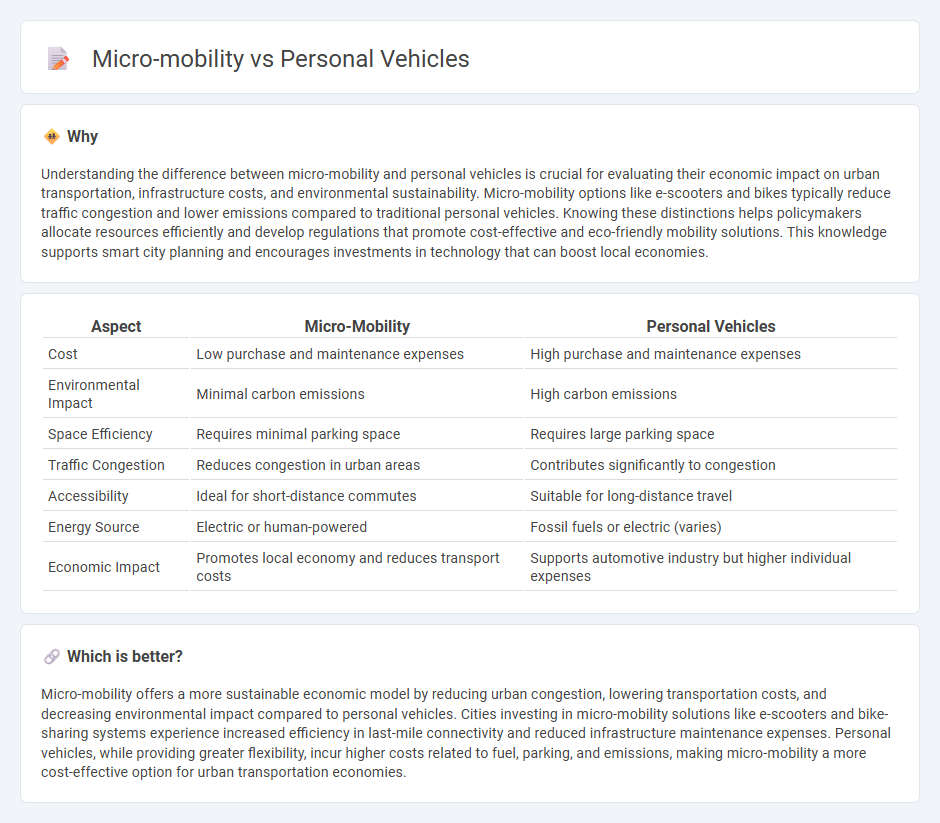
Micro-mobility solutions such as e-scooters and bikes offer cost-effective, efficient alternatives to traditional personal vehicles by reducing fuel expenses and lowering urban congestion. These compact transportation options contribute to decreased carbon emissions and improved air quality, aligning with sustainable city initiatives. Explore how micro-mobility is reshaping economic and environmental landscapes in urban transportation.
Why it is important
Understanding the difference between micro-mobility and personal vehicles is crucial for evaluating their economic impact on urban transportation, infrastructure costs, and environmental sustainability. Micro-mobility options like e-scooters and bikes typically reduce traffic congestion and lower emissions compared to traditional personal vehicles. Knowing these distinctions helps policymakers allocate resources efficiently and develop regulations that promote cost-effective and eco-friendly mobility solutions. This knowledge supports smart city planning and encourages investments in technology that can boost local economies.
Comparison Table
| Aspect | Micro-Mobility | Personal Vehicles |
|---|---|---|
| Cost | Low purchase and maintenance expenses | High purchase and maintenance expenses |
| Environmental Impact | Minimal carbon emissions | High carbon emissions |
| Space Efficiency | Requires minimal parking space | Requires large parking space |
| Traffic Congestion | Reduces congestion in urban areas | Contributes significantly to congestion |
| Accessibility | Ideal for short-distance commutes | Suitable for long-distance travel |
| Energy Source | Electric or human-powered | Fossil fuels or electric (varies) |
| Economic Impact | Promotes local economy and reduces transport costs | Supports automotive industry but higher individual expenses |
Which is better?
Micro-mobility offers a more sustainable economic model by reducing urban congestion, lowering transportation costs, and decreasing environmental impact compared to personal vehicles. Cities investing in micro-mobility solutions like e-scooters and bike-sharing systems experience increased efficiency in last-mile connectivity and reduced infrastructure maintenance expenses. Personal vehicles, while providing greater flexibility, incur higher costs related to fuel, parking, and emissions, making micro-mobility a more cost-effective option for urban transportation economies.
Connection
Micro-mobility solutions, such as e-scooters and bike-sharing, complement personal vehicles by providing efficient last-mile transportation options, reducing urban congestion and parking demand. Integration of these modes with personal cars through apps and shared mobility services enhances accessibility and sustainability in urban economies. Investment in infrastructure supporting both micro-mobility and personal vehicles drives economic growth by fostering innovation and expanding transportation choices.
Key Terms
Cost of Ownership
Personal vehicles exhibit high total cost of ownership due to expenses in fuel, maintenance, insurance, and depreciation. Micro-mobility options such as e-scooters and bikes present significantly lower upfront and operational costs, making them budget-friendly alternatives for short-distance travel. Explore detailed cost comparisons and savings potential by diving deeper into micro-mobility economics.
Urban Congestion
Personal vehicles contribute significantly to urban congestion, accounting for nearly 60% of city traffic during peak hours. Micro-mobility options such as e-scooters and shared bicycles reduce congestion by offering efficient, space-saving alternatives for short-distance travel. Discover how integrating micro-mobility can alleviate urban traffic challenges and improve city commute dynamics.
Last-Mile Connectivity
Personal vehicles often face challenges like traffic congestion and parking scarcity in last-mile connectivity scenarios, limiting urban mobility efficiency. Micro-mobility solutions such as e-scooters, bikes, and shared electric vehicles provide flexible, cost-effective, and environmentally friendly alternatives for short-distance travel within cities. Discover how integrating micro-mobility with existing transportation networks enhances last-mile connectivity and urban transportation systems.
 dowidth.com
dowidth.com